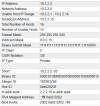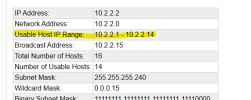customer gave me an address range, ex 10.2.2.2 /28 how do i use this? always had just the 4 octets. i know its sub netting but how do enter the addresses to the cams?
thanks
thanks
What is it your're doing?customer gave me an address range, ex 10.2.2.2 /28 how do i use this? always had just the 4 octets. i know its sub netting but how do enter the addresses to the cams?
thanks
customer gave me an address range, ex 10.2.2.2 /28 how do i use this? always had just the 4 octets. i know its sub netting but how do enter the addresses to the cams?
thanks
10.2.2.2 with subnet mask 255.255.255.240, and they PROBABLY don't care what IP addresses the cameras have as long as the NVR can communicate with them properly.10.2.2.1 for their own router/firewall, and 10.2.2.3 through 10.2.2.14 are unused or reserved for future use.You're off by one. The usable IP range for that subnet isUse mask 255.255.255.240 and IP addresses in the range 10.2.2.2 to 10.2.2.15
10.2.2.1 to 10.2.2.14. The broadcast address is 10.2.2.15.
10.2.2.100 falls outside of the useable address range. Citing the screen shot from @bp2008 below:I've worked with TCP/IP address for many years and set up many private networks, but never really grasped the reason you would configure the subnet this way, 255.255.255.240 or /28 for only 14 usable addresses.
What is the advantage of setting such a small subnet?
If I were to set a static IP address outside of the range, say 10.2.2.100, will this address not be seen (routed) on the network?
I think I mentioned before, "from what I've learned so far, there is always more to learn."

One reason could be - creating a segment dedicated to a specific purpose, and assigning it to a VLAN such that there is no unauthorised access.What is the advantage/disadvantage of this type of network with so few addresses?
Only because it CAN be done. And maybe because of a bit of misplaced fear about IPv4 address scarcity. The privateOK, I see that thanks for the quick response.
What is the advantage/disadvantage of this type of network with so few addresses? Is it some effort at security by limiting the total number of ip addresses?
Or is it, it's being done only because it can be done?
10.x.x.x IP address space has nearly 17 million addresses. It is enough for 65536 distinct /24 subnets (a.k.a. subnet mask 255.255.255.0) so there is not much reason to ever use smaller subnets./28 often when they want to sell a block of addresses to a customer, but that is because they actually do have a scarcity problem that isn't just imagined.You're off by one. The usable IP range for that subnet is10.2.2.1to10.2.2.14. The broadcast address is10.2.2.15.
